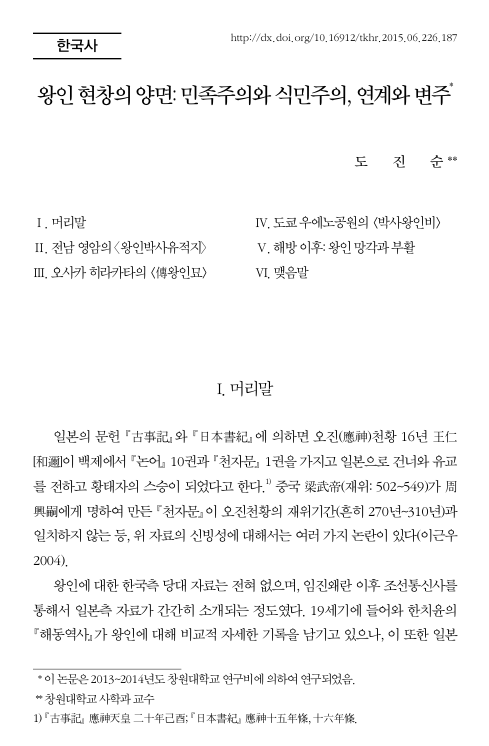도진순, 2015, 〈왕인 현창의 양면-민족주의와 식민주의, 연계와 변주〉, 《역사학보》226, 역사학회.

Ⅰ. 머리말 Ⅱ. 전남 영암의 〈왕인박사유적지〉 Ⅲ. 오사카 히라카타(枚方)의 〈전(傳)왕인묘〉 Ⅳ. 도쿄 우에노공원의 〈박사왕인비〉 Ⅴ. 해방 이후 : 왕인 망각과 부활 Ⅵ. 맺음말
It has been a while here in Korea that Wang-In(王仁) of Baekje Dynasty has been getting the spotlight as a national hero who transmitted the Thousand-Character Text(千字文) and advanced culture to the ancient Japan. The Historic Site of Wang-In in YeongAm-gun;JeollaNam-do province;which claimed to be his birthplace despite the lack of any reliable historical evidence. It has been the host to large-scale commemorative spring and autumn festivals. In this Site;there are variety of monuments and artifacts;including a handwriting by the former President Kim Dae-Jung. Initially;Wang-In was an ‘obscure figure,’ virtually unknown throughout the whole period of Korean traditional history. It was not until the colonial period by the Empire of Japan that the embellishments began extensively. Two of the representative cases were the Alleged Cemetery of Wang-In in Hirakata near Osaka and the Monument of Wang-In at Ueno Park in Tokyo. This study points out that it would be extremely dangerous to portray Wang-In as a leading figure of Korean nationalism;without serious criticisms on the embellishments imposed as part of the colonial policy of Naesonilche(內鮮一體;Korea and Japan are One);since he is viewed as a pro-Japan of the colonial memory in Japan. Based on these considerations;this study examines the connections and variations between colonialistic origin in Japan and nationalistic resurrection in Korea on the embellishment of Wang-In.


의견쓰기
0 개의 의견이 있습니다.